One of the most interesting and, at the same time, challenging agricultural activities that can be taken up by entrepreneurs is village chicken farming. Village chicken farming has some unique benefits that make it a desirable option for small-scale farmers.
In this guide, we will discuss some of the key aspects of village chicken farming. We will explore the basics of starting and running a local poultry farm. We will also discuss some of the advantages of this farming system and provide tips to help you get started.
What is Village or Local Chicken Farming?
Village or Local chicken farming is a type of poultry farming that is carried out in rural, low-income areas. The farmers usually rear indigenous breeds of chickens, which are well-adapted to the environment and local conditions. This form of farming is important because it provides a cheap and convenient source of protein for the people who live in these rural areas through the local poultry farms or household rearing.
The chickens that are raised in this type of farming are usually called “village chickens” or “local chickens”. These chickens are different from the commercial breeds of chickens that are reared in industrialized poultry farms. The main difference between these two types of chickens is that the local chickens are well-adapted to the harsh environmental conditions that are common in rural, low-income areas. They can survive on a diet that consists mainly of locally available food items. In contrast, the commercial breeds of chickens require a specialized diet and a controlled environment in order to survive.
The key feature of the village or local chicken farming is that it is based on the use of indigenous chicken breeds that are well-adapted to the local conditions. These chickens are typically smaller than the commercial breeds, and they have higher disease resistance. They also lay eggs that are small in size but are rich in nutrients.
Some production facts about local chickens
- A local rooster weighs about 1.4-2 kg at maturity while a local hen weighs 1.2-1.5 kg at the point of lay.
- At 22-26 weeks of age, village or local chickens are sexually mature to start mating and producing eggs. A local broody hen could lay up to 72 eggs in a year while a local non-broody hen could lay up to 102 eggs in a year.
- A free-range hen will lay the first eggs at the age of 22-28 weeks and lay 3-4 clutches of 10-15 eggs a year.
Common Local Chicken Breeds
There are three major breeds of local chickens in Nigeria. They are:
- The Frizzled Feathers chicken
- The Naked-Neck chickens
- The Dwarf chicken
Frizzled Feathers chickens are the most popular breed of chicken. They are popularly known for their frizzled plumage. They are hardy, dual-purpose birds that lay eggs occasionally and can be used for meat production.
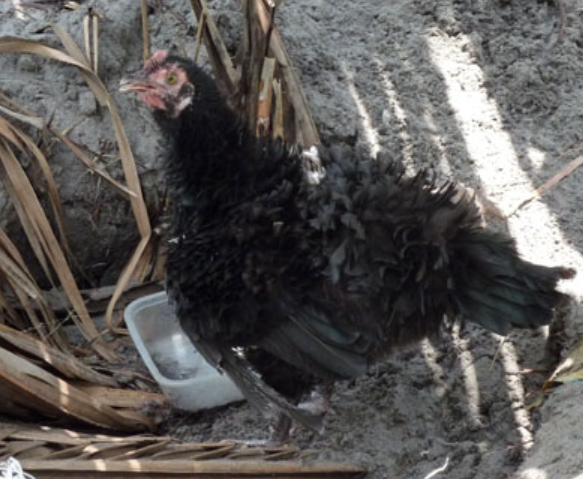
Naked-Neck chickens are a rare breed. They don’t have feathers on their neck and head. They make good scavengers and are good at foraging for food. They are also resistant to diseases. These chickens are hardy and adapt well to different climates. They are also known for being good layers of eggs.
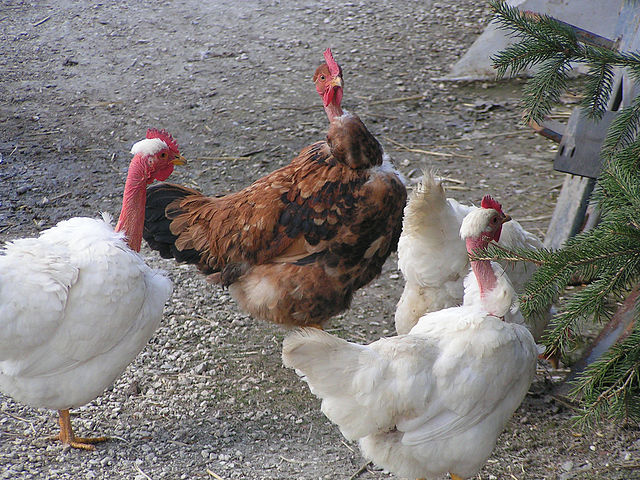
Dwarf chickens are small, compact chickens that are well suited for backyard flocks. They are prolific egg layers and have a calm temperament.
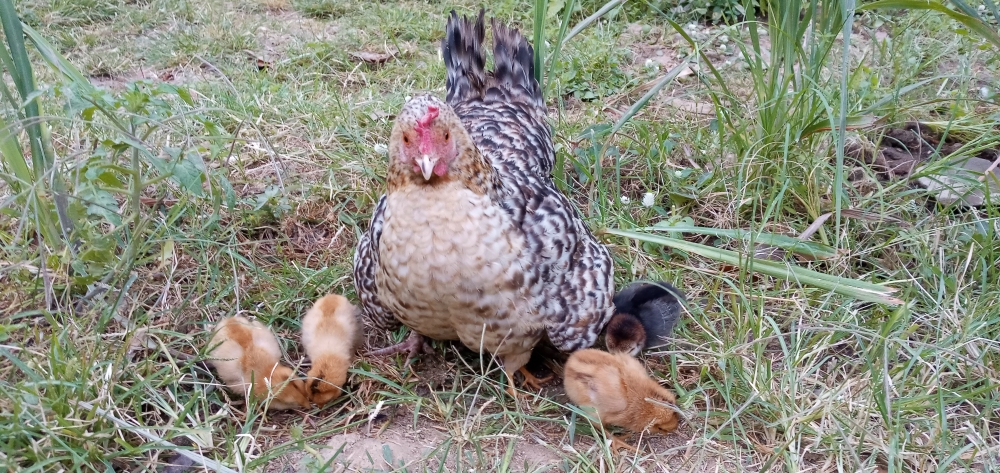
Advantages of Village or Local Chicken Farming
- It is an affordable way to produce eggs and meat
- It helps to improve the livelihoods of rural families.
- Village chickens can scavenge food items in the local environment, which reduces the need for supplemental feed.
- This type of farming also helps to preserve indigenous chicken breeds, which may eventually lead to the development of new chicken breeds that are better adapted to local conditions.
- They are self-sustaining i.e. can raise their own replacement stock
- They are hardy birds that can survive hard conditions.
- Management requirements are not critical as those of commercial exotic breeds
- They are immune to some diseases and parasites
- Their products fetch more money than those from exotic birds
Disadvantages of Village or Local Chicken Farming
- They have a low growth rate
- They produce fewer small-sized eggs and comparatively little meat.
- Chickens may be vulnerable to disease if they are not kept in clean and sanitary conditions.
- The eggs and meat from village chickens may not be as commercially viable as the products from commercial breeds.
- They have been neglected by breeders or scientists despite their potential.
Types of Local Chicken Production Systems
There are three main types of village chicken farming management practices that you can use without significant investments. They are:
- The traditional free-range system
- The semi-intensive range system
Each has its own benefits and drawbacks, so it’s important to choose the one that fits your needs and resources.
Traditional Free Range System
In this system, chickens are allowed to roam free and scavenge for food. They are usually kept in small flocks of 10-20 birds and are allowed to roost in trees or on elevated perches. This system is low-cost and simple to manage, but it can be difficult to protect the chickens from predators. In addition, the quality of the eggs and meat is often lower than those of chickens that are raised in more intensive systems.
Semi-Intensive Range System
In this system, chickens are kept in a large pen or enclosure that is surrounded by a wire fence. The pen is typically filled with a mixture of dirt, sand, wood chips, or other materials that can be used as a substrate for scratching and pecking. Chickens in this system are typically given some access to outside areas, but they are generally not allowed to roam free. This system is more expensive than the traditional free-range system, but it is easier to manage and provides better protection from predators. It also produces higher-quality eggs and meat.
Also Read: Beginner’s Guide to Raising Broilers from Start to Finish
Housing of Local Chickens
Housing is important for keeping poultry safe from predators, thieves and bad weather. It’s also important for the poultry farmer to have a comfortable and convenient poultry house. This will help with production and efficiency.
Different poultry houses and shelters can be found in tropical regions, depending on the availability of materials and weather. It’s important to choose a chicken house based on the costs, durability, and other benefits that it offers.
How to build a local chicken house
- Decide how many chickens you want to house. The chicken house should be at least 2 square feet per bird, so a minimum of 4 square feet is needed for 4 birds.
- Choose a spot for the chicken house that is sheltered from wind and weather, has good drainage, and has plenty of sunlight.
- Choose materials that will be easy to clean and will resist decay. Cedar, redwood, vinyl, or metal are all good options.
- Build the frame of the chicken house using 2x4s or other lumber. The walls and roof can be made from any lightweight material such as plywood, corrugated metal or straw.
- Make sure the door is large enough for the chickens to enter and exit easily, and attach a latch to keep them out at night.
- The house has to be so large that there is sufficient room for the birds, and so that the air inside does not become too heavy with humidity and gasses. A house of 1.5-2.0 m² will hold 10-12 adult birds.
- Install nest boxes, roosting bars or perches, and a feeding trough inside the chicken house.
Basic rules for good village or local chicken housing
- The chicken house should be dry and well-ventilated.
- House should be designed to keep predators out.
- The floor of the house should be sloped so that the chickens can easily clean themselves and the litter removal is easy.
- There should be enough perches so that all the chickens can sleep at night.
- House should be big enough for the maximum number of chickens you plan to keep.
- Chickens need a source of light, either natural or artificial, for 16 hours per day for good health and egg production.
- Chickens like to scratch in the dirt, so make sure they have a place to do that inside the house.
- There should be a way to provide fresh water and food inside the house.
- The house should be easy to clean.
- The house should be well insulated in the cold periods to keep the chickens warm.
Feeding of Local Chickens
Although village chickens can survive on a diet of insects, seeds, and other vegetable matter, providing them with a balanced ration will improve their health and egg production. The main ingredients in a good chicken feed are grains (maize, wheat, barley), soybean meal, vitamins and minerals.
Pellets or crumbles that are specifically designed for chickens are the best way to provide a balanced diet, but scratch (a mixture of grains and cracked corn) or home-made feed can also be used. Village chickens should have access to clean water at all times.
Feeds for Local Chicken
Chickens are a valuable source of protein for people in developing countries. They are also a sustainable source of food because they can eat food that is not fit for human consumption.
One way to feed village chickens is to give them kitchen scraps. You can also give them grains, such as corn and millet. You can also give them fresh vegetables, such as cabbage, lettuce, and carrots.
Farmers can mix their own feeds using the abundant carbohydrate and protein feed available in their area. Feeding should be accompanied by greens and fruits. Only palatable green feeds should be given to birds. Avoid poisonous feeds.
Some green plants to feed local chickens
- Black jack
- Alfalfa
- Bitter leaf
- Edible Amaranthus
- Pawpaw leaves
- Moringa leaves
- Waterleaf
- Lemongrass
- Banana leaves
Avoid giving the following poisonous or unpalatable greens to your chickens.
- Jimsonweed
- Ferns
- Fresh cassava leaves
- Fresh sweet potato leaves
- Tobacco leaves
- Castor oil leaves
- Common St. Paul’s Wort (common Indian weed)
- Sunflower leaves
- Irish potato leaves
- Tomato leaves
- Dichrocephala latifolia
- Tagetes munita
- Pumpkin leaves
Health and Disease Management of Local chickens
Local chickens provide a valuable source of food and income for rural families, but they are also susceptible to diseases that can cause significant losses. Inappropriate health and disease management can lead to increased mortality, reduced egg production, and economic losses.
Good hygiene and biosecurity practices are essential for preventing and controlling diseases in village chickens. Farmers should practice proper sanitation, use clean water and feed, and isolate sick birds. Vaccination and the appropriate use of drugs are also important for preventing and controlling diseases.
Simple rules for disease prevention in chickens
- Keep your chickens healthy and strong by providing a good diet and clean living conditions.
- Vaccinate your chickens against common diseases.
- Use appropriate medications to treat sick chickens.
- Isolate sick birds from the rest of the flock. If medication is not available then kill the sick birds.
- Burn or bury killed birds.
- Practice good hygiene and biosecurity.
- Don’t put too many chickens together in this same coop or house.
- If you’re keeping different poultry species such as chickens, ducks, turkeys and guinea fowls, don’t keep them together but separately.
- Build shelters against wind and rain.
- Clean houses regularly and apply limewash on the floor and the walls.
- If necessary, provide dry litter regularly.
- Separate chicks from adult birds except for the mother hen.
Signs of healthy birds
- Alert and on guard
- Bright eyes and comb
- Walk, run, stand, and scratch continuously
- Eat and drink normally
- Lay eggs normally
- Smooth and neat feathers
- Soft compact droppings
Signs of sick or unhealthy birds
- Tired and lifeless
- dull eyes and comb
- sit or lie down
- eat and drink less
- lay less or stop laying eggs
- ruffled and loose feathers
- wet droppings with blood or worms and diarrhea
- cough, sneeze and breathe noisily
Medication and Vaccination
There are many ways to treat diseases. Some can be cured with medication or drugs, such as parasitic diseases that can be treated with anti-parasitic drugs or baths in oil. Many bacterial diseases can be cured with antibiotics. However, there is currently no cure or treatment for viral diseases, though they may often be prevented through vaccination.
Vaccination
All chickens should be vaccinated against the most common viral disease(s) in the area. Vaccination schemes at the village level should cover Newcastle Disease, Fowl Pox, and Gumboro Disease. Avian Influenza vaccination may be recommended by veterinarian authorities, but other viral diseases such as Marek’s disease are often less important at the village level. A bacterial disease such as Fowl Cholera may also be prevented by vaccination.
Young chickens should be vaccinated and treated for parasites before they start laying eggs. Most young birds that have not been vaccinated are more susceptible to disease and often die. Vaccines should only be given to healthy birds; if you vaccinate a sick bird you may kill it. Anthelmintics against internal parasites should be given two weeks before vaccination to improve the effectiveness of the vaccine.
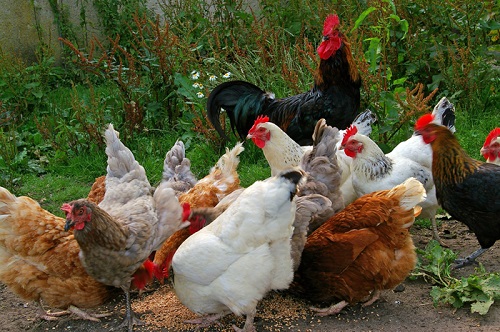
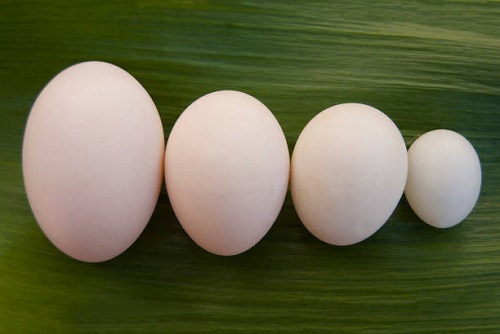
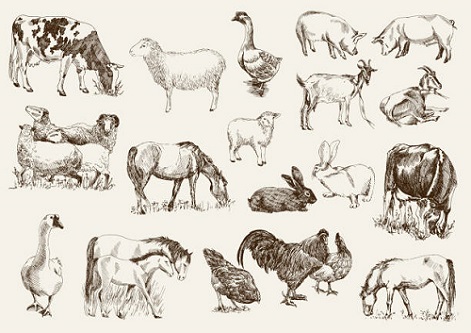
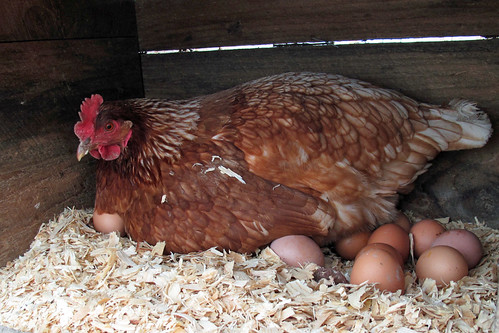
May God bless you for such wealth of knowledge. I am interested in starting free range poultry farming.
I would like to get more information. Thank you
Very informative.
My questions are:
…..why boil the egg – won’t the boiled egg begin to spoil and start smelling over the incubation/hatching period?
……..You said “give each bird own nest when they start to lay. Place dry grass on top”
Place dry grass on top ?
…..is it to prepare the inside of nest
Or
….the dry grass on top of the laid eggs
Thanks
1. Boiled eggs cannot explode or smell except the shells have been peeled. So as along as the shell is intact, there is nothing to worry about.
2. Lol. It is to prepare the inside of nest. The dry grass serves as a cushion to avoid crack or breakage.
Thanks a lot for the opener, God will continue to enrich you at all good things in Jesus name
Sir, can wood shaving b use in place of dry grass? How can d green leaves b use to feed d birds and I what proportions
Thanks
Yes, you can use wood shavings in place of dry grasses. Just hang the green vegetables using a rope. The birds will come and eat them whenever they feel like.
This has been very useful and thx alot
You’re welcome!
Thanks a lot , pls Can I place dry grass in my local incubator to avoid egg crack ?
Yes, you can.
Comment:
Hi, thank you for these information. God bless you.
For the incubator, must it have electricity 24/7?
Yes, your incubator should be functioning always.
Thank you Sir,
Please what to do when you can see some wild hens always attacking others in their nest when laying and incubating?
Separate them or try to prevent them from having access to one another.
Hello sir, good evening. Please do you have Goats that can give 3 or more kids at once and has the high survival rate.
Oliver.
No
Good day sir, please what will I do when my hen start laying, should I leave the egg on the nest or shall I be taking them and keep it on a safe place ? Thank u
Take them and keep them in a safe place.
My hen sometimes drink her own egg after laying egg what shall I do
Click this link http://www.livestocking.net/causes-cure-egg-eating-poultry to discover ways to solve this issue.
Eat her! It’s hard to get them to stop once they start.
Very usefull information
Question:
Why use boiled egg. Have it atract hen to sit and start hatching?
Yes, it attracts them to lay more.
How can i start local chicken business
and medication
Everything you need is in my ebook on Local Chicken Farming Business. Visit http://www.livestocking.net/shop to get it
Very informative page, I have some problems with my local chickens, I noticed when the hatch, and the mother carry them around, the chicks die one by one, they mostly drop their wings and close eyes before dying, and the I decided to artificially brood them, I noticed the same thing, meanwhile I give them only grinded and broken guinea corn and corn. Could it be cold killing them, CRD ?…
Also what are the vaccination schedule for local chickens, are they thesame as broilers and co, can I possibly pay for the ebook by transfer ?, are you on what’s app?
Sorry for your losses. I will email you now.
Can I add local chicks to day old broiler?
No, it’s not good to do so.
I’m a Ugandan who has been googling these poultry keeping procedures.You have stated that after ten days of one hen starting incubation on boil eggs if the rest haven’t joined say among the 13 hens you either eat the eggs or sell it.What if most of the Hens haven’t joined during this period won’t it be a waste of business since your major internation is to produce chicks?
Well, a serious businessperson will buy an egg incubator to make the incubation process easy and convenient.
Is it bad to put tobacco leaves in the chicken house
No, it isn’t.
How long do the timber peeling spend in the chicken house
Edmond from soroti uganda
I bought some local big chicken which were not vaccinated and ineed to vaccinate them soon and my worry is that my neighbor vaccinated his and all died. please some i dvice.
Why did local hens jump during laying period ( if lays today, tomorrow will not) what causes that?
It is normal as egg production takes about 26 hours in chickens and local chickens have poor egg production rate.
POXERFUL AND EDUCATIVE.
Thank you
What is the advantage or disadvantage of feeding local hen with feeds main for agric chicken?
There is no disadvantage. They will even perform better with such feed. However, if you are for organic poultry farming, you can use such feed except they are certified to be organic feed.
Interested in pourtry farming business
Yes
Keep educating us the youth such that we fight the enemy called poverty
Thanks Bernard